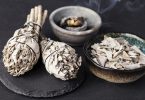As many of you already know, meditation and art go together swimmingly. The two have a mutually beneficial, reciprocal relationship. Meditation can help to free your mind and help creativity flow, while art can express the present moment in a way that enhances and illuminates meditation. It’s a beautiful cycle.
There are many ways for art and meditation to interact. One great way is to paint “portraits” of your chakra energy during or after a chakra meditation. Doing this can really help you to deeply understand each of your chakras and how the energy in each particular one is flowing. In turn, you can see clearly which chakras need your attention and love the most.
You don’t have to be skilled in painting to do this exercise; all you need is a willingness to express yourself and a few basic materials.
Gather your art materials
Any medium can be used to depict your chakras. The important thing is to choose one that resonates with you. If you like to paint (or would like to start painting), go for that. You could also get a sketchbook and colored pencils or pastels. Fingerpaints can work wonders, and add the element of touch to the experience. Even a piece of regular paper and some crayons would do the trick.
You could do a black and white drawing if you really wanted to, but depicting chakra energy may be more effective when using color. It’s ultimately up to you, but using color may add a dimension of insight into the process.
Choose a room to meditate in, then gather your materials and place them near where you will be meditating. Setting up an easel or a desk in the room and laying out your materials beforehand is ideal, so that the time between your meditation and your art will flow more smoothly, without interruption.
Painting your chakras
First, start off with a regular meditation: relax your entire body, paying attention to your breath, and draw your mind to the present. Then, start meditating on your first chakra of choice. A common practice is to start with your root chakra and go up from there all the way to your crown, but you can do this any way you feel is best for your particular needs.
Take time to really feel each chakra. Try to visualize what the energy looks like. What color (or colors) is it? What patterns do you see? Is there a certain movement to the energy? Can you discern any objects, faces or other concrete things, or is it more abstract? Keep this picture in your head.
Once you’ve fully meditated on a chakra, slowly get up and go over to your art materials. Start painting or drawing what you’ve experienced during your meditation, using the colors, shapes, patterns and movements you felt. The feel of the piece is more important than technique here. Don’t think too much as you paint or draw; let the memory of your meditation, and your subconscious, do the work.
Note: Traditionally, each chakra is assigned a color of the rainbow, with the root chakra being red, and the crown being purple, with the other chakras in between corresponding to the other rainbow colors in order. The crown chakra is also sometimes symbolized as white (the all-encompassing color). You can use this as a guide or starting color palate if you wish, but be sure to add other colors you visualized during your meditation.
After you are satisfied with your chakra drawing, go back to your meditation, relax and breathe again. Then, start on your next chakra. You may wish to do this in several separate sessions. If you feel tired or taxed after one chakra, do the next on a different day, or at least after a good break. Don’t push yourself — let these sessions come naturally.
Analyzing the results
When you are through with your meditation, take the time to study the painting or drawing you have done of each chakra. Don’t be critical of your art, just observe and learn. Does the drawing make you feel positive or negative? Do the colors look bright or are they very dark? Are there soft, gentle patterns or are things more jagged? Are there familiar people, places or things in your drawing? If so, how do these things make you feel? It may be helpful to write your impressions in an accompanying journal or on the back of the drawing, if you prefer.
Looking at your chakra portraits can really help you see where work needs to be done. If, for example, the colors you’ve drawn for your heart chakra are dark, shapes are jagged, the movement is incongruous or you’ve depicted people and places that bring feelings of pain, it may be a sign that you have some work to do on balancing this chakra. If so, focus future healing meditations on your heart chakra; fill it with love and compassion, addressing pain and blockages that may be involved.
Painting these types of chakra portraits can really help you to see the effects of your meditation over time. Maybe one chakra portrait goes from dark colors to light. Perhaps another finally finds harmonious movement. Maybe new images come to light that you have never considered. Lining these portraits up side by side can give you a look at the evolution of your energy over time. Continue the journey.
— Meditation Daily







